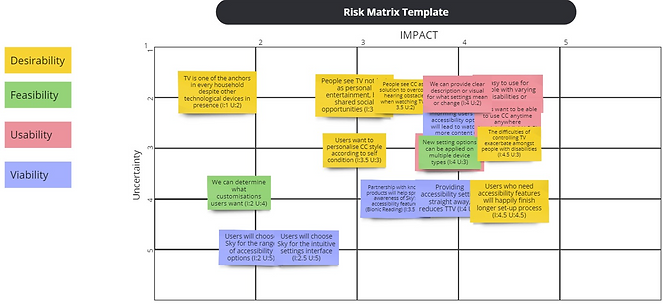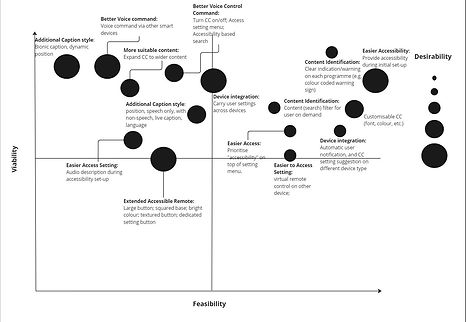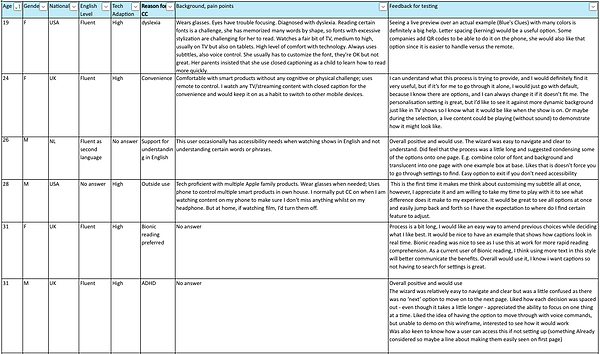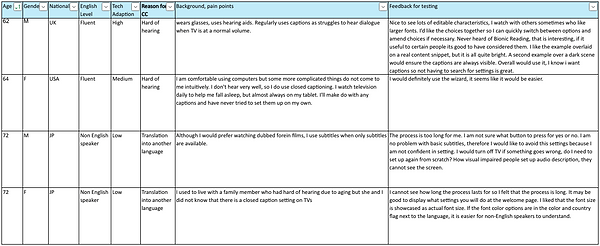
Sky Glass: Inclusive Subtitle
Smart TV Accessibility Initiative
This project aims to enhance accessibility in Sky Glass by developing an "Accessibility Wizard" that simplifies and customises closed caption settings, improving user satisfaction and inclusivity while aligning with regulatory requirements.
Overview
This project focuses on enhancing accessibility in Sky Glass by optimising the closed caption (CC) feature, driven by Ofcom regulations and Sky’s commitment to inclusivity. It addresses the needs of users with physical and cognitive difficulties by proposing an "Accessibility Wizard" that simplifies and customises CC settings during TV setup. Through extensive research and testing, the project identifies pain points such as difficult remote navigation and inadequate customisation options.
The proposed solution aims to increase user satisfaction, adoption, and retention by offering a more inclusive and user-centric experience. Metrics like user adoption rate, engagement, and retention will measure the success of the feature. Further research and refinement are recommended to ensure the solution meets diverse user needs and regulatory requirements, positioning Sky Glass as a leader in accessibility.
Problem statement
Accessibility is often overlooked in product development, despite its importance, especially within the entertainment industry. With recent Ofcom regulations emphasising accessibility, we see optimising the closed caption (CC) feature as a valuable opportunity to further Sky’s commitment to inclusivity and accessibility, while driving business value.
To articulate the user problem this proposed feature is designed to address, we have summarised the problem statement from given user personas as follow:
I am an individual with physical and cognitive difficulties that can disrupt my day-to-day life. I'm trying to find an intuitive and customisable CC setting that allows me to fully enjoy my TV viewing experience and cope with my condition. But, I'm struggling because most CC settings on TVs are hard to access and do not cater to my preferences and accessibility needs. I find this very frustrating as it doesn't help resolve my condition, and can cause further unwanted stress.
Centred around personalisation and accessibility, the proposed feature is expected to resonate with a diverse segment of Sky's user base, promoting an inclusive and user-centric platform to increase Sky Glass adoption and user satisfaction.
Assumptions
Several assumptions have been made (As below), with the riskiest being: "Users requiring accessibility features will be willing to complete a longer setup process." Our prototype will specifically test and validate this assumption.
Statement of Business Value
This initiative aligns with Sky’s objective to offer the best product experience through expanding our market reach (adoption), enhance user satisfaction (retention), strengthen its brand reputation (awareness), and mitigate legal risks (churn). This investment will not only benefit users with disabilities but also enhance the overall user experience, creating a more inclusive and equitable service for all customers.

Research & Analysis
Our collaborative strategy included a rotating weekly project manager to ensure task ownership and timely issue resolution. Flexible response windows and collaborative documents were established to support asynchronous work. Our supportive, open-dialogue culture aims to deliver an inclusive closed captioning feature that meets our objectives.
Team members used personal research to source information on markets, competitors, and current features, then shared with the group to be reviewed.
To have effective ideation, we requested team members to do this individually (Dance, 2021), then came together to collaborate; we used blue sky ideation and mind mapping techniques. We organised these documents into collaborative frameworks in Miro, including an opportunity/solution tree and mind map, and 2 frameworks of prioritisation (Three lenses prioritisation matrix & impact/effort matrix; As below), which were developed and refined throughout the project.
Market Insight
In order to understand Sky Glass’ competition, we analysed direct competitors such as Amazon’s OMNI TV and Freely, as well as the closed captioning and accessibility features of major OTTs, such as Netflix and Disney which are both acknowledged as best accessibility UX among people with disabilities (Scope, 2023). Carrying out SWOT analysis of direct competitors (Appendices 6-10), Amazon has a much greater overlap with Sky Glass, whilst Freely corners a different target market by offering a budget-friendly option. One main threat to Sky is how Amazon has successfully integrated Alexa into their Smart TV system, increasing household accessibility in general. Visiting a Sky store, it was noted that the voice commands are limited to on/off and play/pause functionality. Additionally, CC options were hard to find with language settings in a different location, making it difficult to navigate.
When looking at the OTTs mentioned above for accessibility offerings, in particular CC’s offerings, Netflix and Disney+ both offer CC settings that can alter text size, colour and background colour, however these are dependent on device capabilities and don’t always work successfully as seen when tested ourselves (Appendix 2).
Furthermore, regulators such as OfCom and the FCC state that providers should offer customisation options and different ways to make programmes accessible. (OfCom 2024) (FCC, 2021). Furthermore, OfCom states that ‘providers should give instructions to help audiences’. The UK Media Act of 2024 obligates tier 1 services, which includes Sky, ensuring 80% of programming must be subtitled along with other accessibility requirements (RNID, 2024) This Act shows the pressing needs for D&I in media.
User Insights
While the company serves a broad spectrum of customers, a noteworthy segment is the younger, tech-savvy demographic with over two thirds using accessibility services. Representing a significant portion of Sky's users and is increasingly vocal about their expectations for inclusive and user-friendly experiences.
Our research has identified several key pain points shared by a wider demographic (As below & Appendix 3), including difficulties with remote control operation, limited control over viewing experiences, challenges with assistive technology, and frustration with inflexible accessibility features. These challenges often lead to feelings of exclusion and frustration, hindering users’ enjoyment of content.
User Problem from Personas
Surveys carried out by charities Scope & RNID show an increasing need for accessible content, with 48.5% of individuals surveyed stating that CC is an issue (As below). (Scope, 2023)
RNID User research result
RNID study (2023) on hearing-challengedndividuals recommended that platforms offer personalised CC features and better guidance to accessible content. With 12 million people in the UK and 30 million globally experiencing hearing loss, Sky risks missing a significant opportunity to support its user base and enhance its reputation in D&I and CSR. Opportunities to improve subtitle quality and navigation are frequently posted in the Sky Community.
These studies consistently highlight the need for customisable CC settings, intuitive setup processes, and personalised accessibility features.
Using market research, we analysed user personas and their overlapping pain points, together with comments in the Sky community regarding CC, whilst also ensuring adherence to regulatory bodies and factoring in Sky’s own ethos of ‘Addressing inequality by recognising its ethical responsibility as a technology developer to create accessible platforms…’ (Sky 2024). We have proposed the solution below.







Proposed Solution
Product Definition
After evaluating our solutions using several frameworks (Appendices 2-5), we chose to implement the ‘Accessibility Wizard.’ This step-by-step guide walks users through all available accessibility features and personalisation options during the initial setup of their Sky Glass TV. Addressing common issues such as difficulty using the remote, lack of awareness about current and new accessibility features. By bringing settings directly to the user and reducing navigation, the wizard ensures users are informed about the availability of this feature and can easily access a wide range of options to enhance their TV experience. Allowing for customised user preferences and also introduces additional accessibility options not offered by competitors. Integrating these options into the setup process provides users with a seamless and straightforward experience.
Prototype
Metrics & Success Criteria
‘Deliver a solution that offers the best product experience with closed captioning for a worldwide audience on Sky Glass.’
Based on this sentiment, the key metrics to measure & track are listed below:
1. To increase the stickiness of the use of Sky’s closed captioning by 20% by the end of next quarter.
2. Exceed Net Promoter Score (NPS) of 8.0 for users that require CC
3. Decrease users time to Key action by 60% allowing users to quickly see benefits of the product and enhance overall experience.
Our proposed solution makes it easier for all users to access content on their Sky product. By using the following metrics we can assess to what extent we are achieving this goal:
1. User Adoption Rate: Track the percentage of users who enable and complete the wizard feature.
2. Engagement Metrics: Monitor changes in engagement metrics, such as time spent on the platform, the number of videos watched, or interaction rates before and after the feature's implementation.
3. Impact on Overall Product Retention: Analyse if there is an improvement in the overall retention rates after implementing the closed captioning feature.




Validation & Testing
It is important first to validate our prototype by ensuring users actually want the feature and that it solves pain points. For our concept validation, we focused on these aspects according to our riskiest assumption and adapted our prototype accordingly. To validate our concept, we created a test script, instructing users through our original prototype, gaining qualitative feedback (Appendix 3-5).
To mitigate assumptions and biases, we conducted moderated concept testing with 13 users in three age groups who use CC as follows.
We observed that all users could easily navigate through the prototype. 76% reacted positively to the wizard providing guidance and having customisations options all one place, making customisation of CC clear and accessible. We were able to validate that our prototype is supported by users and its problem solution fit. However, 38% of users suggested the process is too long, going against our riskiest assumption. Based on this feedback, we added the option to ‘skip’, and a progress bar. We also changed the order for settings to prevent overwhelm for users. Users with the highest accessibility needs liked the option of keeping one decision per screen, and the prototype was not adjusted to combine options into one screen based on this feedback. Three users showed interest in using Bionic reading and Makaton.
Lastly, we integrated QR code to our prototype to allow mobile device setup as an additional option alongside remote control navigation and voice commands, this solution addresses issues with Sky's remote controller design, which poses challenges for some users. At the same time caters to digital natives who prefer intuitive, quick operations through swipe and tap.





Recommendations & Next Steps
-
We recommend conducting further research and testing with a larger audience to refine the proposed feature. In particular, optimising flow and reducing the number of options on each screen to increase completion rates (Yablonski, n.d.-b), and decrease time-to-value (TTV), whilst providing enough information to cater to all preferences.
-
Certain features like QR code navigation for easier setup and saving closed-caption (CC) options to user profiles, address key pain points but require more in-depth testing before implementation. Additionally, features like integration of Makaton and Bionic Reading®, although promising and have helped people in the targeted user base, need further validation due to limited existing research.
-
To further enhance the prototype, consider integrating third-party accessibility tools, such as Loop hearing, and implementing auto-settings saving across devices. These additions would not only meet accessibility standards but also provide a competitive edge for Sky Glass. Continuous user feedback, coupled with A/B testing of a mid-fidelity prototype, will be essential to validate these features and ensure they align with both legal requirements and user expectations.
Conclusion
-
This study highlights the potential to significantly improve Sky Glass’s accessibility features, catering to a wider audience and enhancing user satisfaction. By focusing on inclusivity, thorough testing and continuous iteration, Sky Glass can achieve both compliance and differentiation in the market, ultimately driving better customer engagement, being at the forefront for accessibility and ultimately improving business success.
References
-
Access and inclusion research (2023). https://www.ofcom.org.uk/phones-and-broadband/accessibility/access-and-inclusion/. (Accessed August 11, 2024)
-
Arroyo Chavez, M. et al. (2024) 'How users experience closed captions on live television: quality metrics remain a challenge,' Proceedings of the CHI Conference on Human Factors in Computing Systems (CHI ’24), p. 16. https://arxiv.org/pdf/2404.10153. (Accessed August 11, 2024)
-
Australian Communications and Media Authority (no date) Subscription TV captioning targets | ACMA. https://www.acma.gov.au/subscription-tv-captioning-targets. (Accessed August 25, 2024)
-
Ballard, J. (2023) Most American adults under 30 prefer watching TV with subtitles — even when they know the language. https://today.yougov.com/entertainment/articles/45987-american-adults-under-30-watching-tv-subtitles. (Accessed August 11, 2024)
-
Baker, N. (2024) Sky vs NOW review. https://www.uswitch.com/tv/guides/sky-vs-now-tv/. (Accessed August 11, 2024)
-
BBC for everyone (2019). https://www.bbc.co.uk/gel/features/bbc-for-everyone. (Accessed August 26, 2024)
-
Bode, K. (2024) Piracy is surging again because streaming execs ignored the lessons of the past. https://www.techdirt.com/2024/01/10/piracy-is-surging-again-because-streaming-execs-ignored-the-lessons-of-the-past/. (Accessed August 11, 2024)
-
Brown, A., Jones, R., Crabb, M., Sandford, J., Brooks, M., Armstrong, M. and Jay, C., 2015, June. Dynamic subtitles: the user experience. In Proceedings of the ACM international conference on interactive experiences for TV and online video (pp. 103-112). Available at: https://www.researchgate.net/publication/275212495_Dynamic_Subtitles_The_User_Experience. (Accessed August 11, 2024)
-
Buchan, S. and Snelling, D. (2024) Argos shoppers rush to buy new Freeview rival that offers 'Sky Glass experience.' https://www.dailyrecord.co.uk/lifestyle/argos-shoppers-rush-buy-new-32903288. (Accessed August 11, 2024)
-
Crossland, Y. (2021) 'Sky Glass: watch the setup process from start to finish,' T3, 6 November. https://www.t3.com/news/sky-glass-watch-the-setup-process-from-start-to-finish. (Accessed August 25, 2024)
-
Dance, J. (2021) Innovation principle #6: Ideate alone first - fresh consulting. https://www.freshconsulting.com/insights/blog/innovation-principle-6-ideate-alone-first. (Accessed August 25, 2024)
-
Davidson, J. (2024) Amazon Fire TV Omni QLED review: one of the best-featured cheap 4K TVs you can buy. https://www.techradar.com/televisions/amazon-fire-tv-omni-qled-review. (Accessed August 11, 2024)
-
Empson, L. (2023) Amazon Fire TV Omni vs Sky Glass: which streaming QLED TV is best for you? https://www.whathifi.com/advice/amazon-fire-tv-omni-vs-sky-glass-which-streaming-qled-tv-is-best-for-you. (Accessed August 11, 2024)
-
English language skills (2018). https://www.ethnicity-facts-figures.service.gov.uk/uk-population-by-ethnicity/demographics/english-language-skills/latest/. (Accessed August 11, 2024)
-
European Countries by population (2024) - Worldometer (no date). https://www.worldometers.info/population/countries-in-europe-by-population/. (Accessed August 11, 2024)
-
FCC (2021) Closed captioning on television. https://www.fcc.gov/consumers/guides/closed-captioning-television. (Accessed August 25, 2024)
-
Freely | All your favourite TV shows, all in one place and all for free (no date). https://www.freely.co.uk/. (Accessed August 11, 2024)
-
Goldenberg, G. (2021) Can turning on the subtitles really improve the literacy levels of millions of children? https://my.chartered.college/research-hub/can-turning-on-the-subtitles-really-improve-the-literacy-levels-of-millions-of-children/. (Accessed August 11, 2024)
-
Harris, E. (2023) YouGov survey supports Stagetext’s findings - Stagetext. https://www.stagetext.org/news/yougov-survey-supports-stagetexts-findings/. (Accessed August 11, 2024)
-
Hartley, L. (2022) Recognising the power of literacy when designing services. https://defradigital.blog.gov.uk/2022/09/21/recognising-the-power-of-literacy-when-designing-services/. (Accessed August 11, 2024)
-
Hill, S. (2022) 'XRAI Glass wants to subtitle life for the deaf and hard of hearing,' WIRED, 21 December. https://www.wired.com/story/xrai-glass-caption-ar-glasses-first-look/. (Accessed August 11, 2024)
-
Japan’s closed captions allow 'barrier-free' movie experience for everyone (2022). https://mainichi.jp/english/articles/20220514/p2a/00m/0et/028000c. (Accessed August 11, 2024)
-
Jenkins, A. et al. (2011) Literacy, numeracy and disadvantage among older adults in England, Final Report for Nuffield Foundation. https://www.nuffieldfoundation.org/wp-content/uploads/2019/11/Older20adults20and20writing.pdf. (Accessed August 11, 2024)
-
Lick, J. et al. (2010) The benefits of closed captioning commercials. https://janicelintz.com/wp-content/uploads/2015/03/ana_closedcaption_whitepaper-f.pdf. (Accessed August 11, 2024)
-
Live event captioning solutions: Real time captioning (2024). https://www.ai-media.tv/solutions/events/. (Accessed August 11, 2024)
-
Lucy Murphy on why we’ve chosen to turn on the subtitles for Sky Kids (no date). https://www.skygroup.sky/en-gb/article/lucy-murphy-on-why-we-ve-chosen-to-turn-on-the-subtitles-for-sky-kids. (Accessed August 11, 2024)
-
NIDCD (2024) Quick statistics about hearing, balance, & dizziness. https://www.nidcd.nih.gov/health/statistics/quick-statistics-hearing#:~:text=1%20in%208%20people%20in,based%20on%20standard%20hearing%20examinations.&text=About%205%25%20of%20adults%20ages,54%20have%20disabling%20hearing%20loss. (Accessed August 26, 2024)
-
Ofcom (no date) Ofcom’s Accessibility Best Practice Guidelines – Plain English Summary. https://www.ofcom.org.uk/siteassets/resources/documents/tv-radio-and-on-demand/broadcast-codes/other-codes/plain-english-summary-best-practice-guidelines.pdf?v=357072. (Accessed August 11, 2024)
-
Ofcom (2019) Access and Inclusion in 2018. https://www.ofcom.org.uk/siteassets/resources/documents/research-and-data/multi-sector/accessibility-research/access-and-inclusion/2018/access-and-inclusion-report-2018.pdf?v=320479. (Accessed August 11, 2024)
-
Ofcom (2024) Ensuring the quality of TV and on-demand access services. https://www.ofcom.org.uk/tv-radio-and-on-demand/accessibility/ensuring-quality-of-tv-and-on-demand-access-services?utm_medium=email&utm_campaign=Ensuring%20the%20quality%20of%20TV%20and%20on-demand%20access%20services&utm_content=Ensuring%20the%20quality%20of%20TV%20and%20on-demand%20access%20services%20CID_e1a341a0a2dec80db631d0dfbcd56c47&utm_source=updates&utm_term=announcing%20changes%20to%20our%20Access%20Services%20Code%20and%20associated%20Best%20Practice%20Guidelines. (Accessed August 11, 2024)
-
Ofcom and Kantar Media (2019) Disabled users access to and use of communication devices and services. report. https://www.ofcom.org.uk/siteassets/resources/documents/research-and-data/multi-sector/accessibility-research/access-and-inclusion/2018/research-summary-hearing-impairment.pdf?v=320480. (Accessed August 11, 2024)
-
Ofcom and Kantar Media (2019b) Disabled users access to and use of communication devices and services. report. https://www.ofcom.org.uk/siteassets/resources/documents/research-and-data/multi-sector/accessibility-research/access-and-inclusion/2018/research-summary-multiple-disabilities.pdf?v=320401. (Accessed August 11, 2024)
-
Peckitt, M.G. (2022) “Subtitle Glasses” helping deaf movie goers in Japan. https://barrierfreejapan.com/2022/06/11/subtitle-glasses-helping-deaf-movie-goers-in-japan/. (Accessed August 11, 2024)
-
Rev (2024) Best fonts for captions and subtitles in videos [2024]. https://www.rev.com/blog/caption-blog/7-best-fonts-for-subtitles-and-captions-in-videos. (Accessed August 11, 2024)
-
RNID (2023) Breakdown of respondent’s answers to the question: which of these statements apply to you? Please tick all that apply. https://rnid.org.uk/wp-content/uploads/2023/06/RNID-Subtitle-It-Report_new-1.pdf. (Accessed August 11, 2024)
-
Salon (2021) 'Why your brain loves closed captioning,' 4 April. https://www.salon.com/2021/04/04/why-your-brain-loves-closed-captioning/. (Accessed August 11, 2024)
-
Scope (2023) Video on-demand streaming and accessibility: Survey feedback - Scope for business. https://business.scope.org.uk/article/video-on-demand-streaming-and-accessibility-the-big-hack-survey-feedback. (Accessed August 11, 2024)
-
Scope (2023a) Best video on-demand streaming services for accessibility - Scope for business. https://business.scope.org.uk/article/best-video-on-demand-streaming-services-for-accessibility. (Accessed August 11, 2024)
-
Sherlock, G. (2022) I tried Sky Glass and it understands my boyfriend more than me. https://www.manchestereveningnews.co.uk/whats-on/reviews/tried-sky-glass-hands-free-24106728. https://www.moneysupermarket.com/campaigns/sky-glass/. (Accessed August 11, 2024)
-
Sky Accessibility - ensuring that all our products and services are fully inclusive and easy for everyone to use (no date). https://www.skyaccessibility.sky/. (Accessed August 11, 2024)
-
Sky Accessibility - Board | Sky Community (no date). https://helpforum.sky.com/t5/Sky-Accessibility/bd-p/skyaccessibility. (Accessed August 11, 2024)
-
Sky Accessibility - Board | Sky Community (no date b). https://helpforum.sky.com/t5/Sky-Accessibility/bd-p/skyaccessibility. (Accessed August 11, 2024)
-
Sky Glass – Smarter Than a Smart TV with Sky Built-In (no date). https://www.sky.com/glass. (Accessed August 11, 2024)
-
Sky Glass guide | MoneySuperMarket (no date). https://www.moneysupermarket.com/campaigns/sky-glass/. (Accessed August 11, 2024)
-
Stream from Virgin Media | TV Streaming Device (no date). https://www.virginmedia.com/tv/stream. (Accessed August 11, 2024)
-
Stringer, J. (2022) Subtitling for commercials: Are you making the most of your ads? - ZOO Digital. https://www.zoodigital.com/news/subtitling-for-commercials/. (Accessed August 11, 2024)
-
Translate speech to text with Live Caption - Android accessibility Help (no date). https://support.google.com/accessibility/android/answer/9350862?hl=en-GB. (Accessed August 11, 2024)
-
TransPerfect (2023). https://www.transperfect.com/blog/impact-live-closed-captioning-live-entertainment-and-events. (Accessed August 11, 2024)
-
Turn on the subtitles (no date). https://www.turnonthesubtitles.org/. (Accessed August 11, 2024)
-
Wybrow, L. (2024) 10 best alternatives to Sky TV in the UK. https://www.radiotimes.com/technology/technology-guides/best-sky-tv-alternatives/. (Accessed August 11, 2024)
-
Vaughan, J. (2024) Media Bill passes and becomes the Media Act 2024! https://rnid.org.uk/2024/05/media-bill-campaign-win/. (Accessed August 26, 2024)
-
XRAI Glass (no date). https://www.youtube.com/@xraiglass. (Accessed August 26, 2024)
-
Yablonski, J. (no date) Hick’s Law | Laws of UX. https://lawsofux.com/hicks-law/. (Accessed August 26, 2024)
Appendix
1. SWOT Analysis:
Sky Glass
Freely
Amazon
2. Competitor’s Close Caption Examples
Options selected for CC on mobile device :
How it appears on OTT:
3. User Persona Feedback
4. User Testing Script / Objectives
Objective:
-
To verify that the Accessibility Wizard for TV Closed Captioning settings is user-friendly and meets the needs of all users, including those with disabilities
-
To verify that the Closed Captioning settings chosen by the users are sufficient to establish legibility during their TV Viewing experience
Test Environment:
-
Simulated Device: Sky Glass (Version TBD)
Instructions for users:
Imagine you are someone who has little to no hearing/someone who uses subtitles for other accessibility needs. I’m going to walk through settings for a closed captioning feature on a television. At each step, please feel free to provide your feedback and comments and whether the information on the screen would suit your needs.
Any data from this test will only be used for improving this specific feature and will not be shared or used for any other purpose. You will be anonymized for this test and can request for us to remove your data at any time.
Test Case
USER REQUIREMENTS: Must be able to see set up process and actuate remote
Accessibility Wizard Launch - New Customer
Launch the Accessibility Wizard
Closed Captioning
-
Toggle options for closed captionings and descriptive audio
-
Confirm the selection
Language Selection
-
Select a language
-
Confirm the selection
Font Size
-
Select font size
-
Confirm the selected setting
Font Style
-
Select font style
-
Confirm the selected setting
Special Font Styles
-
Bionic reading with toggle
-
Makaton with toggle
Caption Color
-
Select text color
-
Confirm the selected settings
Background Color
-
Select background color
-
Confirm the selected settings.
Background Transparency
-
Select background transparency
-
Confirm the selected settings.
Save and Apply Settings
-
Complete all customization steps in the wizard
-
Select "Complete" at the end of the wizard
-
User will be returned to the main TV interface
Expected Results:
-
All settings should be saved and applied correctly.
-
Closed captions should display as per the user's customization.
-
No errors or settings reset should occur.
Questions for User:
-
Would you use the process?
-
Would you prefer to use this process over manually selecting every setting?
-
Is there anything that you would like to add?
Feedback collection
Demographic Information
-
Age Range: General age ranges (18-24, 25-34, 35-44, 45-54, 55+).
-
Gender: Male, female, non-binary, prefer not to say.
-
Location: Country or region
-
Language Proficiency: Native language and proficiency in the language(s) used in closed captioning.
-
Disability Status: Whether the user has a disability (e.g., hearing impairment, visual impairment) that influences their use of accessibility features
Sociographic Information
-
Media Consumption Habits: Frequency and types of media consumed (e.g., TV shows, movies, streaming services).
-
Technology Comfort Level: Self-assessed comfort level with using technology (e.g., beginner, intermediate, advanced).
-
Accessibility Feature Usage: Whether and how often the user utilizes other accessibility features on their TV (e.g., screen readers, voice control).
Feedback-Specific Information
-
User Experience with Closed Captioning: Specific feedback on ease of use, satisfaction with customization options, and any challenges faced.
-
Frequency of Use: How often they use the closed captioning feature (e.g., always, frequently, occasionally, rarely).
5. Uset Testing Result








